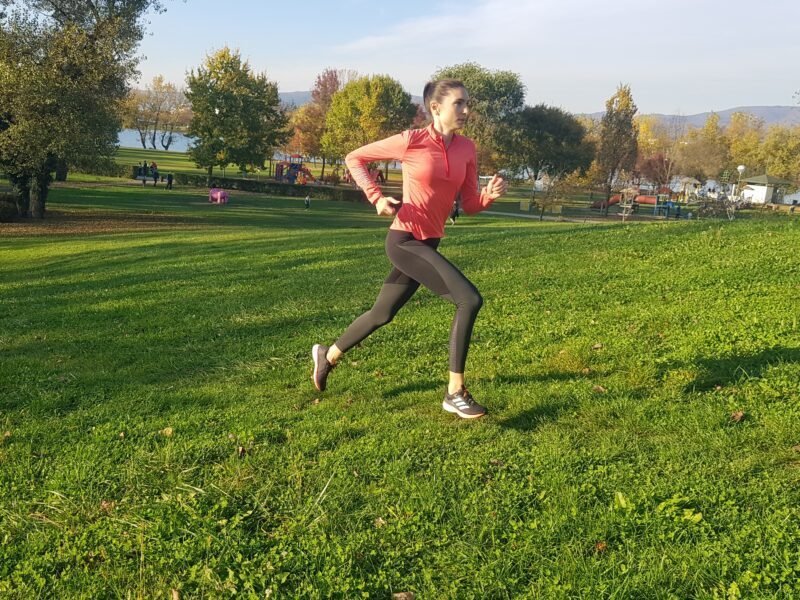Different Types of Runs + 12 Workout Examples
Do you want to improve your running?
Variety is important for progress in running. This means that it is necessary to include different types of runs and train different energy systems to induce certain changes and adjustments in the body.
Include different types of runs into your training plan and you will become a better runner.
Tip
If you do the same workout day after day, running the same distance at the same pace every time, you will make progress up to a certain point. If you do not give your body new stress and challenges, the results will stagnate and even a drop in form will occur.
It is not recommended to do the same type of workout every day, but it is important to combine different types of runs to improve your efficiency and avoid injuries.
It is also important to adjust the intensity of your training to your current fitness level and running goals.

1. Easy run
An easy run is one of the most important types of runs for runners because it helps in recovery from more intense training, and improves endurance and aerobic base.
It should be, as the name says, less intense and you should feel comfortable and relaxed.
It is best to run it by feel.
Tip
Easy running is beneficial for all runners, from beginners to advanced runners. It is an important part of a complete training plan and helps to achieve running goals and maintain general fitness.
What is the purpose of an easy run?
Easy run serves as a warm-up before a particular workout, as a cooldown after training, or as recovery, as a separate workout.
By running easy, you build your basic aerobic fitness, developing your cardiovascular system.
What pace should an easy run be?
Easy running run at a conversational pace, by feel. This means you can talk while running without getting out of breath.
You can’t run easy runs too slow, just too fast. A common mistake runners make is running too fast on days when they should be doing low-intensity workouts.
The subjective feeling can deceive you, so it is advisable to use a smartwatch.
An example of an easy run for beginners
20 minutes of easy running
An example of an easy run for advanced runners
30 minutes of easy running
2. Fartlek
Fartlek is a type of training that consists of continuous running during which you alternate between faster and slower segments. The term comes from Swedish and translates as ˝speed play˝.
Fartleks are great for adding variety to your training plan.
It is a moderate-intensity workout that does not greatly exhaust the body.

What is the purpose of fartlek training?
Fartlek is used to improve speed, endurance, and strength, and allows easier control of changes in pace during the race.
The goal of fartlek training is to adapt the body to different running speeds.
The result of this study demonstrates that fartlek training has a significant influence on improving the maximum oxygen consumption and resting pulse rate, which directly leads to better endurance.
What pace should you run fartlek training?
Fartlek is run by feel, without monitoring the running pace. Listen to your body. When you are running, it does not matter how fast you are going, but how you feel.
The pace varies from slow running up to 70% of your maximum speed.
The fast sections are run at a fast but controlled pace, at about 70% of the maximum, while the slower sections are run at an easy pace to recover and prepare yourself for a faster section.
Tip
If you are running with a watch, try not to bother yourself with your pace. Set yourself an option on the watch to tell you when to speed up and when to slow down.
Most importantly, enjoy and play with speed.
Read more: What is Fartlek? (12 Creative Fartlek Training Examples)
Example of fartlek training for beginners
Fartlek 20′ = 5′ + 10′ (1′-1′) + 5′
- 20′ – the total duration of the fartlek is 20 minutes
- 5′ – 5 minutes of warm-up running at a light intensity
- 10′ (1′-1′) – 10 minutes is the part where fast and slow sections alternate, more precisely 1 minute faster, then 1 minute slower run
- 5′ – 5 minutes of very light jogging (cooldown)
An example of a fartlek workout for advanced runners
Fartlek 50′ = 10′ + 1′-2′-3′-4′-5′-4′-3′-2′-1′ with 1′ easy between + 7′
- 50′ – the total duration of the fartlek is 50 minutes
- 10′ – 10 minutes of warm-up running at a light intensity
- 1′-2′-3′-4′-5′-4′-3′-2′-1′ with 1′ easy in between – run faster for 1 minute, then slower for 1 minute, then faster for 2 minutes, then slower for 1 minute, and so on until the prescribed sequence is completed
- 7′ – 7 minutes of easy running (cooldown)
3. Interval training
Interval training is a type of training in which a specific number of high-intensity interval repetitions are performed with a predetermined recovery time.
The recovery time between intervals gives the body a break, reducing the risk of injury and the stress that comes from running fast.
It is popular among runners because it provides great variety in training. It can be adapted to different ability levels of runners and their goals.
Tip
Adjust the running speed, duration of intervals, and recovery time to your abilities and running goals.
What is the purpose of interval training?
Interval training is used to improve speed, stamina, and endurance.
It also increases tolerance to pain and discomfort and helps develop a sense of pace.
At what pace should you run interval training?
Run short intervals of 200m-400m at 1500m race pace or mile race pace, medium intervals of 400m-800m at 5K race pace, and long intervals of 800-1000m at 10K race pace.
An example of interval training for beginners
5 x 500m, P 90”
- Warm up with 10 minutes of easy jogging, do mobility exercises and dynamic stretching exercises, then do running drills and strides. Take a rest. Then run a total of 5 intervals of 500 meters. After each interval, there is a 90-second break of standing still. After you finish the main part of the workout, run for 5 minutes with a light jog (cooldown).
An example of interval training for advanced runners
8 x 1000m, P 2′
- Warm up with a 2-mile easy run, do mobility exercises and dynamic stretching exercises, then do running drills and strides. Take a rest. Then run a total of 8 intervals of 1000 meters. After each interval, there is a break of 2 minutes of standing still. After you finish the main part of the workout, run for 1 mile with an easy run (cooldown).
4. Tempo run
A tempo run is a type of training that develops the ability to withstand a higher intensity of effort over a longer period of time. It can be done by doing a certain number of reps with recovery in between or by running continuously.
This type of workout can be characterized as comfortably hard.
What is the purpose of a tempo run?
Tempo run improves speed and endurance, increases the body’s ability to break down lactic acid (increases the lactate threshold), increases tolerance to discomfort, helps control emotions when it becomes difficult and increases resistance to fatigue.
What pace should you run tempo run?
Tempo runs you should do it at a pace that is challenging and comfortably difficult, but not so fast that it causes fatigue after a few minutes of running.
Generally, this is the pace at which you can run for about 60 minutes, which is usually between your 10K and half marathon pace.
Tip
Tempo runs are challenging, but can be sustained over a longer period of time because the goal is to develop endurance and speed. It is important to adjust your training to your current fitness level and gradually increase the intensity to avoid injury.
An example of tempo training for beginners
20′ tempo run
- Warm up with 5 minutes of easy jogging, and continuously, without stopping, move on to the main part of the workout, which is 20 minutes of running at a tempo pace. After you have completed the main part of the workout, continuously, without stopping run for 5 minutes easily (cooldown).
An example of tempo training for advanced runners
3mi tempo run
- Warm up for 2 miles of easy jogging, and continuously, without stopping, move on to the main part of the workout, which is 3 miles of running at a tempo pace. After you have completed the main part of the workout, continuously, without stopping run for 2 miles easily (cooldown).
2 x 2mi tempo run
- Warm up for 2 miles of easy jogging, and continuously, without stopping, move on to the main part of the workout. Run 2 miles at a tempo pace, then run 1 mile at an easy pace, then run 2 miles at a tempo pace again. After you have completed the main part of the workout, continuously, without stopping run for 2 miles easily (cooldown).
5. Long run
The long run is the longest run of the week with the goal of improving endurance and aerobic capacity.
On average, it lasts 1 to 3 hours, and it varies depending on the discipline for which the runner is preparing, training experience, weekly mileage, and tendency to injuries.
There are several variations of long runs, such as long slow-distance runs, race-specific long runs, and progressive long runs.

What is the purpose of the long run?
Long run serves to improve endurance, enables adaptation of tendons, ligaments, bones, and joints to the stress of running, and increases tolerance to pain and resistance to fatigue.
It teaches the body to use fat as a fuel source, rather than glycogen or stored sugar, resulting in longer glycogen stores and avoiding “hitting the wall”.
Likewise, the long run builds your confidence and mental toughness as you learn to deal with discomfort despite leg fatigue.
In addition, it is a great form of rehearsal before a race as it allows you to test equipment and try out refreshments to avoid any possible inconveniences on race day.
What pace should a long run be?
The answer depends on the type of long run that you will be doing.
Long slow distance run you should run at a conversational pace, about 55-75% of your current 5K pace. This means you should be able to talk while running without getting out of breath or overexerting yourself.
Race-specific long runs, you should run part of the workout at a conversational pace and part of the workout at your target race pace.
If you are doing a progressive long run, you need to increase your running pace gradually, without sudden changes in pace.
Start at an easy pace and gradually accelerate to your target pace.
If you run too fast, you may not be able to maintain that pace throughout your workout.
It is important to listen to your body. If you feel tired or sore, you should slow down or shorten the duration of your workout.
Read more: What is Considered a Long Run? (5 Long Run Examples)
An example of a long run for beginners
Long slow distance run – 5mi
- 5 miles of running at a controlled, conversational pace
An example of a long run for advanced runners
Training length specific to the race – 13mi
- 3mi – controlled, conversational pace
- 8mi – 3 x 2 miles at marathon pace with 1 mile at an easy pace
- 2mi – controlled, conversational pace
6. Hill training
Hill training is a type of training that includes running on an incline for a certain number of repetitions or continuously without stopping.
Due to its adaptability, it is great for all runners.
Running uphill reduces the risk of injury due to the reduced returning force that is generated when your body comes in contact with the ground at each step.
Types of hill training are hill repeats, long hill runs, or rolling hills.
Tip
Hill training is a specific form of strength training for runners, but it is not an adequate substitute for strength training. Therefore, keep strength training in your training plan.
What is the purpose of hill training?
Hill training serves to develop strength and improve endurance, stamina, and neuromuscular coordination.
It improves your running form by removing unnecessary movements and improper posture during running.
Likewise, hill training improves your cadence, stride length, and thus the running economy.
A study has shown that 12 weeks of hill training significantly improves stamina, reduces resting heart rate, and improves maximum oxygen intake (VO2 max) in middle- and long-distance runners.
Interestingly, improvements were achieved without significant changes in the risk of injury.

What pace should you run hill training?
The pace at which you should run depends on the type of hill training ahead of you.
However, the general rule is that when running uphill and downhill, you follow the effort of running, not a specific pace. This means that, for example, you run at the 5K effort, not at the 5K race pace.
Short hill repeats run at a high intensity and very hard effort (8-9 RPE). Long hill repeats and long hill runs at a lower intensity and hard effort (6-7 RPE).
Read more: Hill training (8 examples of hill training)
An example of hill training for beginners
Hill repeats 6 x 20”
- Warm-up – 10 minutes of easy running on flat ground
- The main part of the workout – 6 x 20 seconds uphill; recovery is walking down
- Cooldown – 5 minutes of easy running on flat ground
An example of hill training for advanced runners
Hill repeats 3 x 5 x 60m
- Warm-up – 15 minutes of easy running on flat ground
- The main part of the workout – 3 x 5 x 60m uphill; recovery between repeats is a gentle run down, and recovery after the set is walking down
- Cooldown – 10 minutes of easy running on flat ground

Matea Matošević
Hi, I’m Matea! I’m an Olympic Marathon Runner, founder, and writer behind OLYRUN.com. On this site, I provide help in the form of my knowledge and experience to all who love running and active living. Read more…

